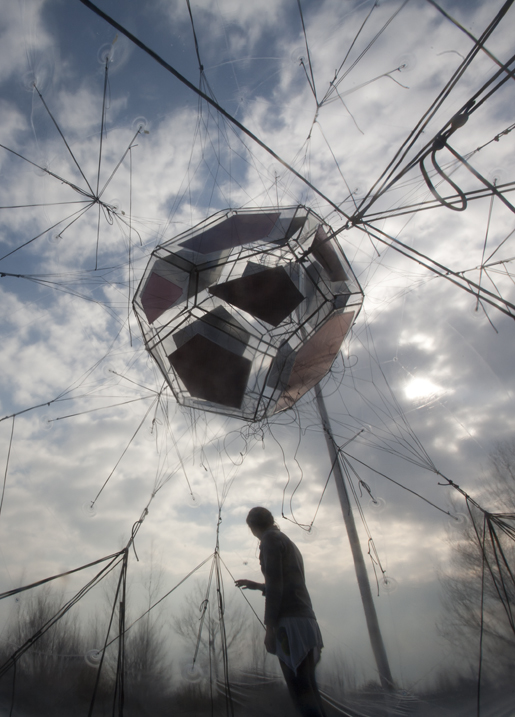
Tomás Saraceno Cloud City, 2011 Courtesy the artist © 2011 Tomás Saraceno
"Cloud City" by Tomas Saraceno.
Carpenter Center for the Visual Arts, Terrace, 24 Quincy Street, Cambridge, MA Public hours: Monday–Friday, 10am–5pm; Saturday and Sunday, 1–5pm.
The work of Tomás Saraceno is widely thought to draw its inspiration from the speculative traditions of fantasy and science fiction, but it is in fact more truly related to problems of contemporary knowledge.
Tomás Saraceno is widely known for his rethinking of urban geography and its potential migration into the physical and political atmosphere over our heads. His inflatable sculpture, Cloud City—part planet, part vehicle, and by definition humanly inhabitable—is embedded with solar technology and sensors that record and interact with aspects of the wider environment. The sculpture has the potential to launch and travel through the atmosphere while harvesting data and communicating back to the installation site.

Olafur Eliasson Common sense, 2011 Courtesy the artist; Tanya Bonakdar Gallery, New York Photo: Jens Ziehe © 2011 Olafur Eliasson
"Three to now" by Olafur Eliasson.
Harvard University Graduate School of Design, Gund Hall, 48 Quincy Street, Cambridge, MA Public hours: Monday–Friday, 9am–5pm; Saturday and Sunday, noon–4pm
The project of Olafur Eliasson has been to subject spatial and aesthetic practice to the rigors of both knowledge and invention, and at one and the same time. But if the spirit of the laboratory and of the counting house seems cold and out of place within an art practice, it is notable that every work of Eliasson figures at once as experiment or “reality test” and as a confident affirmation of the mysteries and enchantments of nature.
Olafur Eliasson’s contribution, Three to now, engages the tacit forms of experience and understanding that underlie both scientific theorization and our knowledge of the exterior world. This installation at the Graduate School of Design consists of 55 technical instruments, machines, and other objects that challenge or subvert the trusted and familiar routines of perception by which we order our comprehension of the physical world.
"Untitled" by Ai Weiwei.
Northwest Science Building, B1 Level, 52 Oxford Street, Cambridge, MA Public hours: Monday–Friday, 7am–10pm
The son of one of China’s preeminent poets and social critics, Ai Weiwei spent much of his early life in internal exile with his family. Twenty years later, the family was permitted to reenter Beijing, his father’s reputation restored to its former glory. Reversals of this kind are a standard aspect of twentieth-century Chinese social history and an undeniable foundation of Ai’s practice and thought.
Chinese artist and architect Ai Weiwei’s installation, Untitled (2011), memorializes the thousands of schoolchildren who died as a result of the major earthquake in China’s Sichuan Province in May 2008. A site-specific work of 5,335 identical school backpacks represents the exact number of children who died during the earthquake and in the subsequent collapses of poorly constructed school buildings. A related sound piece by the dissident artist, a voice recording reciting the names of the victims, titled Remembrance (2010), will play in the space. The counting of the student earthquake victims and collection of details about their deaths are the products of a “citizens’ investigation” conducted by Weiwei and his studio, leading to growing government censure.






















